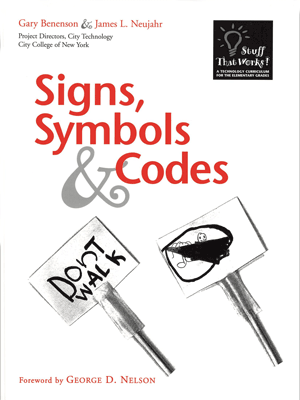Stuff that works:
Books
Signs, Symbols & Codes

Signs, Symbols & Codes
Observing graphic devices found on packages, walls and street signs; analysis of gestures and codes; design of signs & symbols for the school.
This book provides an engaging introduction to the signs and symbols that are pervasive in our environment.
Chapter 1 provides an introduction to them. Some symbols warn us not to do things, but many of them are not very convincing. Others convey hidden messages that do not become clear unless we look closely. There are also signals that do a similar job as symbols, but rely on body language or actions rather than graphic elements. A code is a system of symbols, such as you would find in the key to a map. There are also symbols that are hard to read, so the chapter ends with some “Mystery Symbols” challenges.
Chapter 2 describes how young children learn to use and understand symbols, and how a symbol operates to convey a message. It discusses communication in general, providing examples of how messages can be misinterpreted. All of education involves symbols, such numbers, letters and words, not to mention pictures and talk, so the study of symbols is fundamental.
The activities in Chapter 3 provides examples from grades pre-K through 6, including Special Ed, of children designing symbols for their classrooms and schools. These include hand signals as well as symbols for use in maps posters and for sending secret messages.
Chapter 4, “Stories”, provides accounts by teachers of how they came up with these activities and what happened in their classrooms. Beginning in pre-K, it includes photos of symbols students designed, as well as samples of their writing and thinking, in both English and Spanish. It has pictures they drew of symbols they found on “Scavenger Hunts” in their environments.
The last two chapters provide a broader context for engaging with signs, symbols and codes in the elementary classroom. “Resources” provides references and capsule reviews of children’s literature related to the topic, plus a brief introduction to assessment methods.
The final chapter provides an overview of education standards, and alignments with the standards that were in effect in 2002, including the NCTE/IRA Standards for the English Language, AAAS Benchmarks for Science Literacy, NRC National Science Education Standards, and NCTM Principles and Standards for School Mathematics. While these particular standards documents have all been superseded, most of the discussion of standards is still relevant.
